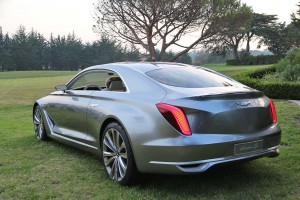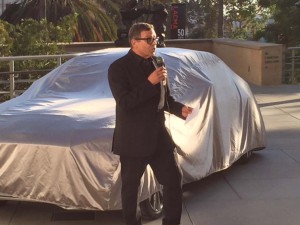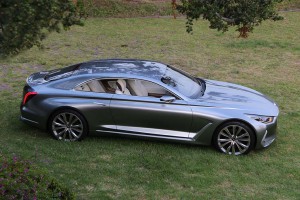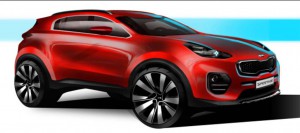Parked on a field off the well-manicured greens of the Pebble Beach golf course, the big coupe almost glows in the late evening sun, drawing admiring stares from the crowd that surrounds it.
For now, the HCD16 Vision-G is just a concept vehicle, but Peter Schreyer is quick to tell you that it will have a significant role in the Hyundai brand going forward. And he should know. The one-time Audi stylist who now serves as co-president of both the Korean carmaker and its sibling brand Kia, Schreyer has won wide praise for transforming two econobox brands into design trendsetters.
“I want to make the brands strong, while keeping them fresh,” said the 62-year-old Schreyer during an interview with TheDetroitBureau.com.
Under Schreyer, Kia launched a series of striking new models, such as the midsize Optima sedan, that took industry observers – and consumers – by surprise. Hyundai has had its own styling successes with models like the midsize Sonata and compact Elantra, both helping it generate major sales gains in recent years.
The Korean maker took a much more conservative approach when it rolled out its big Equus sedan – which targeted the likes of the Mercedes-Benz S-Class and BMW 7-Series – a few years ago. The new Vision-G suggests Hyundai won’t play it safe the next time, Schreyer confiding that key “cues” from the concept coupe will reappear on the next-generation Equus.
(For more on the radical Hyundai Vision-G concept, Click Here.)
The design bears some similarities to other Hyundai products, but it’s not just a full-sized take on the Sonata. The goal was to come up with a unique look that will be shared among future Hyundai luxury models, such as the Equus, the slightly smaller Genesis sedan, and others to follow – possibly a large coupe based on the Vision-G.
“You have to do that to attract and satisfy luxury buyers” who don’t want something that’s just a bigger Sonata, Schreyer said. But he quickly added that “You (also) don’t want to lose the connection between luxury and the rest of the brand. This has to elevate and create a new awareness for Hyundai as a brand.”
While there are some distinct creases and folds to the Vision-G’s sheet metal, the concept vehicle adopts a much more refined and subtle look than that of the Elantra and Sonata. And that reflects Schreyer’s more subtle and holistic approach to design.
“It’s not just about putting down all these lines,” the German-born design chief explained. “I want to get away from the thinking that many young designers have that it is all about surfaces. I want to work more with the architecture of the car, focus more on its proportions.”
It’s as much about “attitudes,” Schreyer suggested, as it is shapes.
(Kia, Hyundai enhance their APEAL, finds new JD Power study. Click Here for more.)
Part of the challenge for Hyundai – and for Kia – as they push into the luxury market is that they are going up against brands with long histories, established images. But Schreyer is intent on using that to his advantage. “We can make use of that (because) we’re more free, more innocent. We can jump to the left and right a little more freely.”
At the same time, he stresses that Hyundai and Kia can’t simply shift directions at will. There needs to be more consistency than, say, with Korean-made cellphones that can be completely redesigned every time a new model comes to market.
“The Korean culture expects something new all the time (which is) the good thing about the Korean mentality, the desire to try something new. But for me, the challenge is not to get lost,” he explained, and consistency is essential to that.
One of the biggest challenges for Schreyer has been trying to visually separate the Kia and Hyundai brands, not an easy task considering they share most of the same underlying components. The Equus, for example, is based on the same architecture as the newer Kia K900.
(Kia shows design evolution with new Sportage. Click Here for a first look.)
That’s the sort of challenge that Schreyer said he looks forward to — and why, despite some recent reports, he said he has no near-term plans to retire.
“It is not in my plans. The work I’m doing is very rewarding and you can see things you are doing very quickly,” he said, admitting with a broad smile, “It is like an addiction.”





Gee, where have I seen that look before? Maybe on a Caddy… The Asian auto makers are notorious for using styling cues from M-B, BMW, Audi and others so that people think with a casual glance that the Asian model is one of the premium German models.
That “tiger nose” and other foolish looking designs should limit sales to a very small group of people. The one area where Asian designers really fail is the most important and that is front end styling. Most of it is really horrible.
I’m interested what you drive? Kia was second in the JD Power Initial Quality Survey this year next to
Porsche. Where was your brand. Kia & Hyundai have made huge leaps in quality over the last five years at a much faster rate than both European and domestic brands. The reason why the design looks European is because a lot of the designers including Peter are European – there not copying designs from a European manufacturer their design studio is in Germany
That is a beautiful car , last year I bought the Sportage Turbo and it is a dream . Here in WV I go everywhere all year long , and during good dry weather it goes down the road !
Thanks
Styling is totally subjective and what some folks like other folks dislike and vice versa. You can tell the more aesthetically pleasing designs by high sales volume. I rank body styling as the number one criteria for most auto buyers.